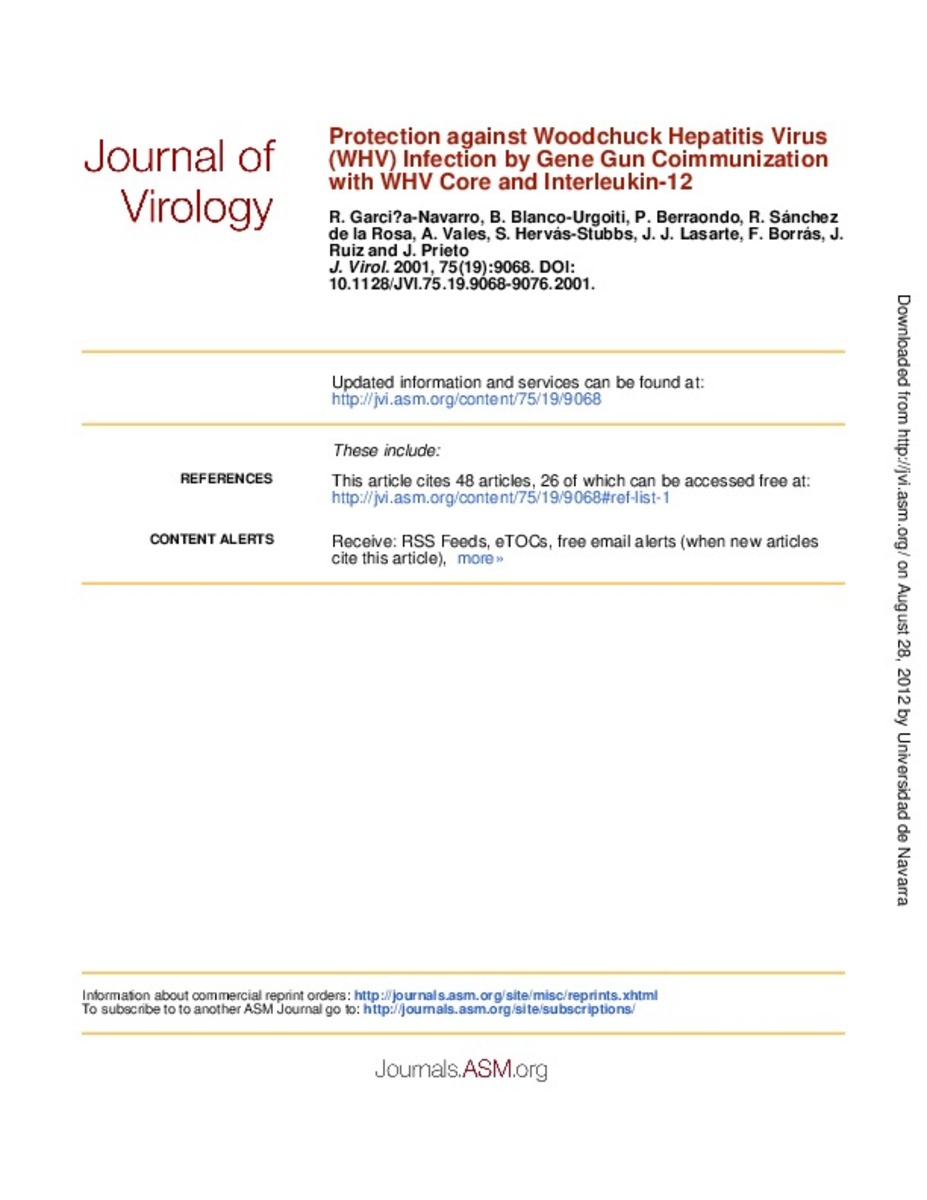Full metadata record
| DC Field | Value | Language |
|---|---|---|
| dc.creator | Raquel | - |
| dc.creator | Blanco-Urgoiti, B. (Begoña) | - |
| dc.creator | Berraondo, P. (Pedro) | - |
| dc.creator | Sanchez-de-la-Rosa, R. (R.) | - |
| dc.creator | Vales, A. (África) | - |
| dc.creator | Hervas-Stubbs, S. (Sandra) | - |
| dc.creator | Lasarte, J.J. (Juan José) | - |
| dc.creator | Borras-Cuesta, F. (Francisco) | - |
| dc.creator | Ruiz, J. (Juan) | - |
| dc.creator | Prieto, J. (Jesús) | - |
| dc.date.accessioned | 2012-01-26T15:40:24Z | - |
| dc.date.available | 2012-01-26T15:40:24Z | - |
| dc.date.issued | 2001 | - |
| dc.identifier.citation | Garcia-Navarro R, Blanco-Urgoiti B, Berraondo P, Sanchez de la Rosa R, Vales A, Hervas-Stubbs S, et al. Protection against woodchuck hepatitis virus (WHV) infection by gene gun coimmunization with WHV core and interleukin-12. J Virol 2001 Oct;75(19):9068-9076. | es_ES |
| dc.identifier.issn | 0022-538X | - |
| dc.identifier.uri | https://hdl.handle.net/10171/20619 | - |
| dc.description.abstract | Woodchuck hepatitis virus (WHV) and hepatitis B virus (HBV) are closely similar with respect to genomic organization, host antiviral responses, and pathobiology of the infection. T-cell immunity against viral nucleocapsid (HBcAg or WHcAg) has been shown to play a critical role in viral clearance and protection against infection. Here we show that vaccination of healthy woodchucks by gene gun bombardment with a plasmid coding for WHcAg (pCw) stimulates proliferation of WHcAg-specific T cells but that these cells do not produce significant levels of gamma interferon (IFN-gamma) upon antigen stimulation. In addition, animals vaccinated with pCw alone were not protected against WHV inoculation. In order to induce a Th1 cytokine response, another group of woodchucks was immunized with pCw together with another plasmid coding for woodchuck interleukin-12 (IL-12). These animals exhibited WHcAg-specific T-cell proliferation with high IFN-gamma production and were protected against challenge with WHV, showing no viremia or low-level transient viremia after WHV inoculation. In conclusion, gene gun immunization with WHV core generates a non-Th1 type of response which does not protect against experimental infection. However, steering the immune response to a Th1 cytokine profile by IL-12 coadministration achieves protective immunity. These data demonstrate a crucial role of Th1 responses in the control of hepadnavirus replication and suggest new approaches to inducing protection against HBV infection. | es_ES |
| dc.language.iso | eng | es_ES |
| dc.publisher | American Society for Microbiology | es_ES |
| dc.rights | info:eu-repo/semantics/openAccess | es_ES |
| dc.subject | Hepatitis B/immunology | es_ES |
| dc.subject | Hepatitis B/prevention & control | es_ES |
| dc.subject | Hepatitis B Virus, Woodchuck/immunology | es_ES |
| dc.subject | Interleukin-12/immunology | es_ES |
| dc.title | Protection against woodchuck hepatitis virus (WHV) infection by gene gun coimmunization with WHV core and interleukin-12 | es_ES |
| dc.type | info:eu-repo/semantics/article | es_ES |
| dc.relation.publisherversion | http://jvi.asm.org/content/75/19/9068.full | es_ES |
| dc.type.driver | info:eu-repo/semantics/article | es_ES |
Files in This Item:
Statistics and impact
Items in Dadun are protected by copyright, with all rights reserved, unless otherwise indicated.






